Student Blog: Dana Briggs
The Journey of a Real Scientist
It’s 4:00 on a sunny Friday afternoon, and it feels like I have sent and received a hundred emails today. Meetings are lined up all next week with various group members to discuss the logistics of this project. There is also talk of how we will analyze our final data, but I must admit that I hardly know where we will start.
When I used to picture a scientist, I imagined her going into the rugged field with strange equipment to make groundbreaking discoveries. Her research is exciting, inspiring, and important to our world! I began to wonder, when do I become a scientist—a ‘real’ scientist? It feels like I am missing out on some essential part of science that is somehow more complex or important than the tasks I am doing at the moment. The self-doubt creeps a little further. Am I doing enough? Do I have what it takes? When do I become a ‘real’ scientist?
It is my final year in the MCRS program, and we have finally received our capstone project groups. It almost feels surreal to be at this point in my academic career—so close to the end, but so much to do at the same time! I am going to be handed a degree and released into the scientific community to join the “real” scientists. It is exciting and daunting all at the same time, but it is time to begin. Our team has set out to understand the water quality parameters within Lower Newport Bay and how they impact the eelgrass beds found here. Eelgrass, which is a marine plant, is an essential part of bays and estuaries that provides ecosystem services such as habitat structure, oxygen exchange, food, and water filtration (Heck Jr. et al. 2003, Moore et al. 2006). Eelgrass also reduces turbidity, or cloudiness, in the water column by slowing water flow and increasing settlement of suspended particles (de Boer, 2007). Because eelgrass provides so many services that shape the structure and health of their habitats, eelgrass is known as a keystone species (Carroll 2016). Their influence on ecosystem productivity combined with their sensitivity to water quality shifts makes eelgrass a widely used indicator for ecosystem health (Biber et al. 2008). In Lower Newport Bay, juvenile leopard sharks, bat rays, California halibut, pacific staghorn sculpin, shiner surfperch, and rockfish all utilize the eelgrass beds here (Sherman & DeBruyckere, 2018).
As someone who has worked mostly in terrestrial settings, this aquatic environment was a new set of challenges and inspiration. In addition, we were essentially building a new project from the ground up—from field methods to final analysis. We certainly have our work cut out for us!

Fast-forward a couple months down the road. Our team had faced many challenges with varying degrees of control over the situation. The supply chain has been a nightmare, learning to use all this foreign equipment was a challenge to us all, and fine-tuning the methods from laptop to field also proved to be easier said than done. Despite all these challenges, they actually showed how real-world projects are never perfect and will always encounter challenges. In the mess of it all, we were learning, troubleshooting, and collaborating just like real-world scientists tackling their own problems. I am starting to realize that every task and challenge is part of the journey for any scientist. We have successfully designed our sampling procedure, gone out most weeks to collect data, and we even began training volunteers to help us collect. We have accomplished so much! But, just when I am beginning to feel like a real scientist, I am thrown a challenge that none of us expected: the kayak flipped during a sampling event, and our equipment sank to the bottom of the cloudy-green harbor. I feel a wave of shock, disbelief, and my own heart sink. I wonder if this is the end of our project.
I force myself to snap out of the disbelief and spring into action. We quickly assembled a team to try to retrieve the gear. I grab my wetsuit, head to the bay, and we begin free diving at the last known location. The gear may not be waterproof, but there is a chance of salvaging it if we can rescue it today. As I dive in, I soon realize that the visibility is so poor that I can hardly see the bottom 14 feet down. We search and search, but our efforts yield no luck. One thing I have learned through this project is that when a curveball is thrown, you keep trying new ways to tackle the problem. We call off the search to bring in salvage divers who may have better resources and luck to find the lost items. After the second day of searching with no success, we decided to call off the search and shift towards a new plan.
Although we did not find the lost equipment, all hope was not lost for the project. We accepted the loss and began devising plans to acquire replacement gear. In addition, we have also strategized new ways to secure our gear to the kayak, or at least make sure it floats if it falls out. We will regroup and come back with a stronger plan that will account for more risks and risk management. In all the chaos and hurdles of this moment, I have realized science is not about being perfect. In fact, if you’re trying to be perfect, you probably are not going to learn anything new. We must try new things, test them to their breaking point, and go back to the drawing board for a new plan. Science is about collaborating with others when you do not have the answer, trying new things and failing, and exploring the unconsidered. Sometimes this looks like sending emails back and forth all week to craft a plan, and other times it means getting creative with the limited resources you have. After collaborating with what I once thought of as “real scientists,” I have since realized that this was an illusion; every scientist is on a journey of trials and successes. If we accept our mistakes as part of our growth, then we can become better scientists every day. After being on this whirlwind experience of grad school, I have realized that I have been a scientist my entire life, and every seemingly insignificant step or hiccup has been part of the journey to the scientist I am today, and the scientist I will be tomorrow.
References
Biber, P. D., Gallegos, C. L., & Kenworthy, W. J. (2008). Calibration of a bio-optical model in the North River, North Carolina (Albemarle–Pamlico Sound): a tool to evaluate water quality impacts on seagrasses. Estuaries and Coasts, 31(1), 177–191. https://doi.org/10.1007/s12237-007-9023-6
Carroll, S. (2016). The ecologist who threw starfish. Excerpted from The Serengeti Rules: The Quest to Discover How Life Works And Why It Matters. Nautilus.
de Boer, W. F. (2007). Seagrass–sediment interactions, positive feedbacks and critical thresholds for occurrence: a review. Hydrobiologia, 591(1), 5–24. https://doi.org/10.1007/s10750-007-0780-9
Heck Jr., K. L., Hays, G., & Orth, R. J. (2003). Critical evaluation of the nursery role hypothesis for seagrass meadows. Marine Ecology Progress Series, 253, 123–136. https://doi.org/10.3354/meps253123
Moore, K. A., Short, F. T. (2006). Zostera: Ecology, Biology, and Management. In Larkum, A.W.D., Orth, R.J., Duarte, C.M.Page (45(5), 5). Seagrasses: Biology, ecology and conservation. (pp. 361-386). doi: 10.1007/978-1-4020-2983-7_16
Sherman, K., & DeBruyckere, L. A. (2018). Eelgrass habitats on the U.S. west coast: State of the knowledge of eelgrass ecosystem services and eelgrass extent. Pacific States Marine Fisheries Commission, Creative Resource Strategies, LLC. https://www.pacificfishhabitat.org/wp-content/uploads/2017/09/EelGrass_Repo



